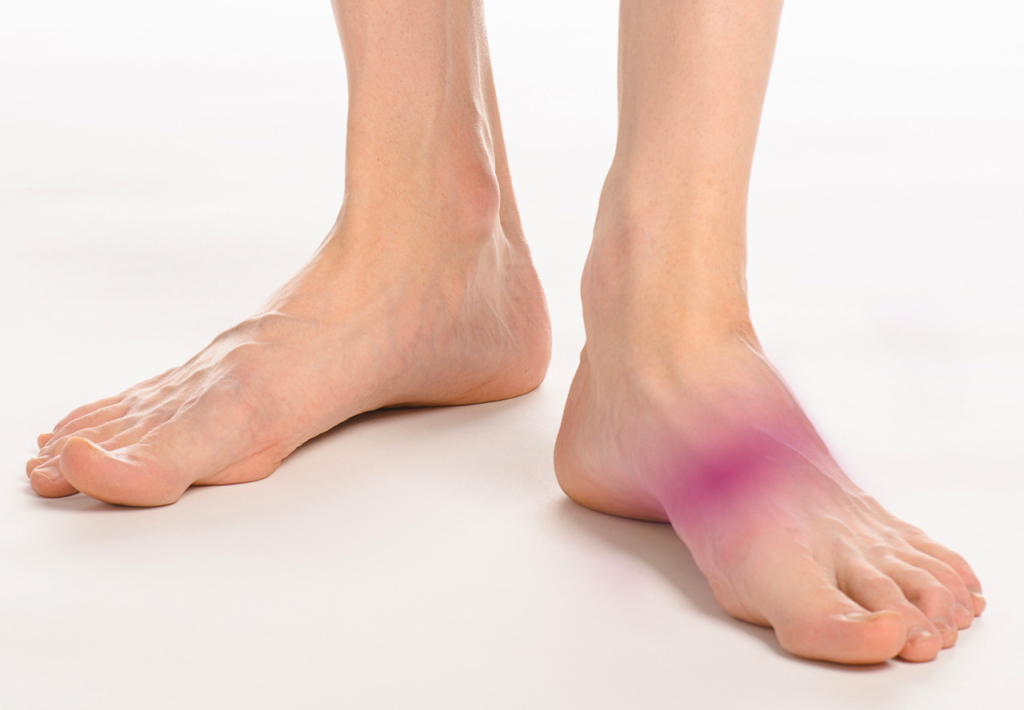
Midfoot Conditions
Structural Problems
Joint and Bone Conditions
-
What it is:
A Lisfranc injury involves damage to the bones or ligaments in the midfoot, specifically at the tarsometatarsal (TMT) joints where the metatarsal bones connect with the midfoot. This injury can range from ligament sprains to fractures and dislocations.Causes:
High-impact trauma (e.g. car accidents, falls)
Sports injuries (especially twisting the foot while it's planted)
Missteps off curbs or stairs
Crush injuries to the foot
Symptoms:
Pain and swelling in the midfoot
Bruising on the top and bottom of the foot
Difficulty bearing weight or walking
Widening of the foot or visible deformity
Tenderness over the TMT joint
-
What it is:
Midfoot arthritis is the degeneration of cartilage in the middle portion of the foot, affecting joints between the tarsal bones and the bases of the metatarsals. It often leads to stiffness and pain with walking or standing.Causes:
Wear-and-tear over time (osteoarthritis)
Previous injuries (like Lisfranc injuries)
Inflammatory conditions (rheumatoid arthritis, gout)
Flatfoot deformity
Symptoms:
Pain in the middle of the foot, especially when standing or walking
Swelling and stiffness in the midfoot area
Difficulty with foot movement or arch support
Bony prominences or changes in foot shape
Pain that worsens with activity and improves with rest
-
What it is:
A navicular stress fracture is a small crack or break in the navicular bone, located in the midfoot. It’s a common injury in athletes and runners due to repetitive stress or overuse.Causes:
Repetitive high-impact activities (running, jumping)
Sudden increase in training intensity
Poor footwear or training surfaces
Bone insufficiency or poor biomechanics
Symptoms:
Gradual onset of vague midfoot pain
Pain worsens with activity and improves with rest
Tenderness over the top of the foot (navicular area)
Swelling may be minimal or absent
Difficulty with high-impact activities
-
What it is:
Accessory navicular syndrome occurs when an extra bone or piece of cartilage (accessory navicular) near the navicular bone becomes irritated or painful. Not everyone with an accessory navicular has symptoms, but it can cause issues when aggravated.Causes:
Trauma or overuse (especially in young athletes)
Flat feet or abnormal biomechanics
Ill-fitting footwear
Irritation from shoes or repetitive motion
Symptoms:
Pain or swelling on the inner side of the foot (arch area)
Visible bump near the navicular bone
Pain when wearing tight shoes or after activity
Difficulty with foot movement or supporting the arch
Tenderness over the bump, especially with pressure
-
What it is:
Flatfoot is a condition where the arch of the foot collapses, causing the entire sole to come into complete or near-complete contact with the ground. It can be flexible (arch appears when non-weight bearing) or rigid (arch is absent even when off the ground).Causes:
Genetics (inherited foot structure)
Weak or stretched tendons (especially the posterior tibial tendon)
Arthritis or joint degeneration
Tarsal coalition or other congenital issues
Injury or trauma to the foot or ankle
Symptoms:
Pain along the arch, heel, or inner ankle
Fatigue or aching in the feet and legs after standing or walking
Flattening of the arch (especially noticeable when standing)
Difficulty fitting into shoes
Rigid flatfoot may cause stiffness and limited foot motion
-
What it is:
Cavus foot is a condition where the foot has a high arch, causing more weight to be placed on the ball and heel of the foot. This imbalance can lead to pain and instability.Causes:
Inherited foot structure
Neurological conditions (e.g. Charcot-Marie-Tooth disease, cerebral palsy)
Muscle imbalances in the leg and foot
Spinal cord or nerve disorders
Symptoms:
High arch that remains even when standing
Pain or calluses on the ball, heel, or outer edge of the foot
Instability or frequent ankle sprains
Clawed toes (hammertoes)
Foot fatigue or imbalance during walking
-
What it is:
Tarsal coalition is a congenital condition where two or more of the tarsal bones in the foot are abnormally connected. This can be a bony, cartilaginous, or fibrous connection that limits motion and can lead to pain and stiffness.Causes:
Congenital (present at birth, often discovered in adolescence)
Can be associated with flatfoot or limited foot flexibility
Rarely, can result from trauma or arthritis
Symptoms:
Stiffness and pain in the foot (often in adolescents)
Difficulty walking on uneven surfaces
Frequent ankle sprains
Rigid flatfoot that doesn’t improve with arch support
Limited side-to-side motion in the foot
Soft Tissue Disorders
-
What it is:
Tendonitis is inflammation or irritation of a tendon, the thick cord that connects muscle to bone. Tibialis posterior tendonitis affects the tendon that supports the arch and runs along the inside of the ankle and foot.Causes:
Overuse from walking, running, or standing
Flatfoot or abnormal foot mechanics
Improper footwear
Sudden increase in activity
Injury or trauma
Symptoms:
Pain along the inside of the ankle or foot
Swelling or warmth in the affected area
Arch collapse (in more advanced cases)
Difficulty standing on tiptoes
Worsening pain with activity or prolonged standing
-
(Can also affect the forefoot)
What it is:
Plantar fasciitis is inflammation of the plantar fascia, a thick band of tissue that runs along the bottom of the foot from the heel to the toes. It's one of the most common causes of heel pain.Causes:
Overuse from running or prolonged standing
Flat feet or high arches
Tight calf muscles or Achilles tendon
Inadequate arch support in footwear
Sudden increase in physical activity
Symptoms:
Sharp, stabbing heel pain (especially with first steps in the morning)
Pain that improves with movement but returns after rest
Tenderness along the bottom of the foot
May cause forefoot discomfort if walking pattern is altered
Tightness in the arch or heel